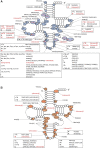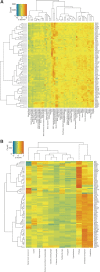Matching tRNA modifications in humans to their known and predicted enzymes
- PMID: 30698754
- PMCID: PMC6412123
- DOI: 10.1093/nar/gkz011
Matching tRNA modifications in humans to their known and predicted enzymes
Abstract
tRNA are post-transcriptionally modified by chemical modifications that affect all aspects of tRNA biology. An increasing number of mutations underlying human genetic diseases map to genes encoding for tRNA modification enzymes. However, our knowledge on human tRNA-modification genes remains fragmentary and the most comprehensive RNA modification database currently contains information on approximately 20% of human cytosolic tRNAs, primarily based on biochemical studies. Recent high-throughput methods such as DM-tRNA-seq now allow annotation of a majority of tRNAs for six specific base modifications. Furthermore, we identified large gaps in knowledge when we predicted all cytosolic and mitochondrial human tRNA modification genes. Only 48% of the candidate cytosolic tRNA modification enzymes have been experimentally validated in mammals (either directly or in a heterologous system). Approximately 23% of the modification genes (cytosolic and mitochondrial combined) remain unknown. We discuss these 'unidentified enzymes' cases in detail and propose candidates whenever possible. Finally, tissue-specific expression analysis shows that modification genes are highly expressed in proliferative tissues like testis and transformed cells, but scarcely in differentiated tissues, with the exception of the cerebellum. Our work provides a comprehensive up to date compilation of human tRNA modifications and their enzymes that can be used as a resource for further studies.
© The Author(s) 2019. Published by Oxford University Press on behalf of Nucleic Acids Research.
Figures



References
-
- El Yacoubi B., Bailly M., de Crécy-Lagard V.. Biosynthesis and function of posttranscriptional modifications of transfer RNAs. Annu. Rev. Genet. 2012; 46:69–95. - PubMed
-
- Chanfreau G.F. Impact of RNA modifications and RNA-modifying enzymes on eukaryotic ribonucleases. Enzymes. 2017; 41:299–329. - PubMed
Publication types
MeSH terms
Substances
Grants and funding
LinkOut - more resources
Full Text Sources
Other Literature Sources

